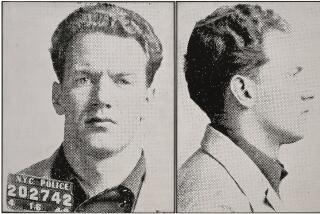History Unbound
- Share via
Everybody knows the Taj Mahal. What most people don’t know is that the exquisite white marble valentine Shah-Jahan commissioned in memory of his wife in the early 1630s is but the most visible piece in a vast body of art produced by the Mughal dynasty in India during a 330-year period.
Angelenos will get a rare glimpse into that world beginning Thursday when “King of the World: A Mughal Manuscript From the Royal Library, Windsor Castle” opens at the Los Angeles County Museum of Art.
With its 44 small, brilliantly colored paintings executed in opaque watercolor on paper, the “Padshahnama” (Persian for “chronicle of the king of the world”) is an illustrated, handwritten history commissioned by Shah-Jahan in 1639. Although the printing press was invented about 90 years before the founding of the Mughal empire in 1526, it had yet to make its way to India, where books were still hand-copied and were the province of the privileged few. Thus the “Padshahnama” was conceived both as a historical record and a work of art.
The “Padshahnama,” one of 40 Islamic manuscripts in the Royal Library, was presented to King George III in 1799 by the nawab, or governor, of Oudh. The Royal Library has exhibited the manuscript on occasion, but because the “Padshahnama” is a bound book, only two pages could be displayed at a time; previously it has only been available to the royal family for viewing in its entirety.
Recently unbound for restoration in honor of the 50th anniversary of India’s independence and the founding of Pakistan, the “Padshahnama” is making a seven-city tour of the world (LACMA is the fifth venue on this journey) and will then return to its original form as a bound book. So see it now or forever hold your peace, because it is unlikely to be this accessible again.
The “Padshahnama” was completed in 1655 in Persian--the formal language of the Mughal empire--by court scribe Abdul-Hamid Lahawri, and it chronicles the first 10 years of Shah-Jahan’s reign. (Similar documentation of the last two decades of his rule has yet to be discovered, if in fact it exists at all.) Comparable to an illustrated diary of daily doings at the White House (with the dirty bits expurgated, of course), the “Padshahnama” focuses for the most part on formal interactions at the royal court.
“These paintings are in the tradition of the modern-day photo-op pictures of the president shaking hands with foreign leaders,” says LACMA associate curator Stephen Markel, who has been with the museum since 1983 and is the curator for the L.A. showing of the “Padshahnama.” “These images were intended to convey the glory of the dynasty, and the scale rarely changes in this period of Mughal art--you don’t get close-ups, for instance--because Shah-Jahan wanted to present himself in as idealized a fashion as possible. In short, this is propaganda celebrating the glory of the empire, and consequently the imagery tends to be a bit formalized and stiff.
“The art of each reign was different. For instance, Shah-Jahan’s father, Jahangir, favored art of a more introspective nature, and during his reign nature studies and surprisingly realistic portraiture flourished. One of my favorite works from this period is a portrait of a dying opium addict--which is something you’d never see in the art produced under Shah-Jahan.”
The Mughal dynasty was founded in 1526 by Babur, a Mongolian prince descended from Genghis Khan--the legendary 12th century Mongolian warrior who took the rape, plunder and pillage routine to unprecedented heights. Babur conquered Delhi, and by the time of his death four years later he had laid the foundation for an enduring empire.
That empire came into bloom as a creative force under Babur’s grandson, Akbar, who ruled from 1556 to 1605 and had an abiding interest in the imperial painting workshops that fostered the development of a new composite style. Akbar’s son, Jahangir, also patronized the arts and had an even more refined eye; the art produced under Jahangir tended toward an introspective simplicity and was remarkably realistic for its day.
Jahangir’s son, Shah-Jahan, was a bit more grandiose--for evidence of that, look no farther than the Taj Mahal. Shah-Jahan, the Mughal dynasty’s greatest patron of architecture, favored a style revolving around symmetry and balance, and his is referred to as “the reign of marble,” which was his material of choice.
In approaching the “Padshahnama,” it seems appropriate to quote that great American philosopher James Brown: “This is a man’s world.” Women are rarely depicted in the manuscript, which is dominated by images of men taking forts, severing heads, killing animals and, above all else, bowing and presenting one another with jewel-encrusted gifts.
“There’s a grand tradition of the exchange of diplomatic gifts between great leaders, and many images in the ‘Padshahnama’ depict this practice,” Markel says.
“And, yes, jewels were extremely important to the Mughals, who considered an elaborate turban ornament to be a symbol of their hereditary right to rule. Anyone who owned gems was automatically an empowered person, and there was a decree that any great diamond found in India’s diamond mines automatically belonged to the emperor.
“However, the Mughals were also very fond of nature--in fact, one way of courting favor was to present the royals with gifts of exotic animals,” says Markel, in reference to the abundant imagery of wildlife in the “Padshahnama.”
Which brings us to the issue of Mughal hunting practices, wherein animals were herded into a fenced area, then hunted and shot by royals on horseback.
“That wasn’t fair,” Markel agrees. “And if I look at these images from a modern perspective, I’m revolted by that practice.
“But the king had the kings’ privileges,” he adds with a shrug. “And, yes, it’s also true that women rarely appear in the ‘Padshahnama,’ but that’s because of the Islamic law of purdah, which prohibits women from being seen in public.”
In perusing the “Padshahnama,” one is also struck by the absence of references to gods and deities.
“You don’t see deities in Mughal art for the obvious reason that Muslims don’t have deities--there’s simply the prophet and his teachings,” Markel says. The Mughal emperors considered themselves “the reflection of God on Earth,” he explains, and saw themselves as invested with divine power, although they did not consider themselves divinities.
Despite such modern-day Western considerations, Markel says, “I’d still assert that the most extraordinary thing about the Mughal dynasty was its remarkable degree of tolerance. Shah-Jahan’s mother was Hindu and his grandfather, Akbar, was a tolerant man who tried to form his own religion based on a synthesis of Muslim, Hindu and Christianity--which is why it’s not unusual to see Christian imagery in Mughal painting.
“The Mughal emperors realized they were a minority among the Hindus and that they were ruling a vast empire populated by people of many different faiths,” he continues. “They understood that the most efficient way to run the empire was to treat everyone fairly, so the integration of Muslims and Hindus under the Mughals was unprecedented. Interfaith marriages were common, and many artists who worked on the ‘Padshahnama’ were Hindu.”
During the course of several different reigns, an official Mughal painting style evolved that centered on lively activity and emphatic gestures, strong colors, impeccably executed detail that reflects a Persian influence and a clearly presented narrative. This was the style to which artists of the royal court were required to conform.
“Mughal art is very much a hybrid that incorporates elements of Persian, Hindu and Christian painting,” Markel says. “One of the great challenges of working within an official style is to express your creativity without violating that style--and many of the artists who worked on the ‘Padshahnama’ [14 of whom have been identified by historians] inarguably achieved that. The range of scenes depicted in the manuscript is fairly narrow, yet several of these artists leave a recognizable stamp on whatever they do.
“The Mughals had considerable exposure to European art, and artists traveled from around the world to India to work at the royal court. The Mughals also imported lots of European decorative art, glasswork in particular, and had connections with the Medici,” he says, referring to the Florence-based family of Italian art patrons whose influence stretched from the 14th through the 16th centuries.
The exchange went both ways, Markel explains:
“Mughal art was popular with Europeans, who found it easy to understand because it was of people and places and incorporated European perspective and realism. Mughal art was collected in Europe from the time that it began being produced--Rembrandt, in fact, owned several pieces of Mughal art--and huge amounts were exported to Europe during the great collection-forming period of the 19th century.”
Despite sophisticated international connections, the Mughals weren’t fully committed to the Age of Reason.
“Astrology was prominent in the Mughal world--in fact, Shah-Jahan referred to himself as ‘the second lord of the auspicious conjunction’--and astrologers were often consulted to determine the most advantageous time to begin a new undertaking,” Markel says. “I’d point out, however, that the Mughals were no more superstitious than any other pre-modern culture.”
Shah-Jahan’s astrological advisors failed him in 1658, when his evil son, Awrangzeb, murdered several of his brothers and nephews and threw his father in jail--which is where Shah-Jahan remained until his death in 1666. Under Awrangzeb, Islamic orthodoxy increased, painting was discouraged at court, and artists were forced to rely on patronage from the nobility in order to survive. Portions of the empire in the northwest began to slip away from Mughal control, and the years 1707-1857 were marked by increasing political disintegration.
The sun finally set on the empire in 1858, when the British exiled the last Mughal emperor to Burma. There’s a certain poetic justice in the fact that the “Padshahnama” is now surfacing courtesy of the British, in honor of their 1947 acknowledgment to Mahatma Gandhi that the governing of India is best left to the Indians.
* “King of the World: A Mughal Manuscript From the Royal Library, Windsor Castle,” Los Angeles County Museum of Art, 5905 Wilshire Blvd. Thursday through May 17. (213) 857-6000.
More to Read
The biggest entertainment stories
Get our big stories about Hollywood, film, television, music, arts, culture and more right in your inbox as soon as they publish.
You may occasionally receive promotional content from the Los Angeles Times.









